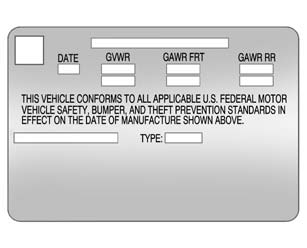Chevrolet Sonic Owner's Manual: Certification Label

Label Example
A vehicle-specific Certification label is attached to the vehicle's center pillar (B-pillar). The label tells the gross weight capacity of the vehicle, called the Gross Vehicle Weight Rating (GVWR). The GVWR includes the weight of the vehicle, all occupants, fuel, and cargo. Never exceed the GVWR for the vehicle, or the Gross Axle Weight Rating (GAWR) for either the front or rear axle.
And, if there is a heavy load, it should be spread out. See ŌĆ£Steps for Determining Correct Load LimitŌĆØ earlier in this section.
Warning
Do not load the vehicle any heavier than the Gross Vehicle Weight Rating (GVWR), or either the maximum front or rear Gross Axle Weight Rating (GAWR). This can cause systems to break and change the way the vehicle handles. This could cause loss of control and a crash. Overloading can also shorten the life of the vehicle.
If you put things inside the vehicleŌĆölike suitcases, tools, packages, or anything elseŌĆöthey will go as fast as the vehicle goes. If you have to stop or turn quickly, or if there is a crash, they will keep going.
Warning
Things inside the vehicle can strike and injure people in a sudden stop or turn, or in a crash.
- . Put things in the cargo area of the vehicle. In the cargo area, put them as far forward as possible. Try to spread the weight evenly.
- . Never stack heavier things, like suitcases, inside the vehicle so that some of them are above the tops of the seats.
- . Do not leave an unsecured child restraint in the vehicle.
- . Secure loose items in the vehicle.
- . Do not leave a seat folded down unless needed.
 Steps for Determining Correct Load Limit
Steps for Determining Correct Load Limit
1. Locate the statement "The combined weight of occupants and cargo should never
exceed XXX kg or XXX lbs." on your vehicleŌĆÖs placard.
2. Determine the combined weight of the driver and ...
Other materials:
Front Opening Upper Cover Replacement
Front Opening Upper Cover Replacement
Callout
Component Name
1
Radiator Opening Upper Cover Screw (Qty:?Ōé¼ŌĆ░10)
Caution: Refer to Fastener Caution.
2
Radiator Opening Upper Cove ...
Engine Replacement
Special Tools
EN-48244 Engine Assembly Remove/Install Pallet Supporter
Removal Procedure
Remove the battery and battery tray. Refer to Battery Tray Replacement.
Relieve the fuel system pressure. Refer to Fuel Pressure Relief.
Recover the refrigerant. Refer to Refrigera ...
Inspection/Maintenance (I/M) System DTC Table
Inspection/Maintenance (I/M) System DTC Table
System
DTCs Required to Set System Status to YES
If an inspection/maintenance system status indicator did not update to
yes during the Inspection/Maintenance Complete System
Set Pro ...
0.0054

